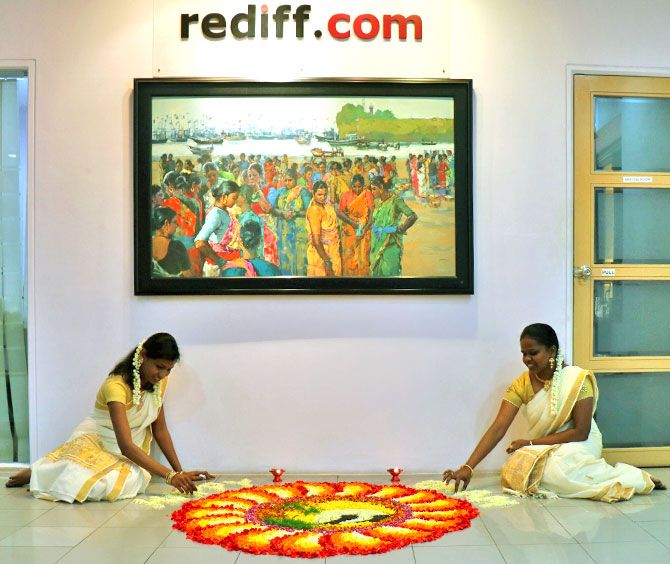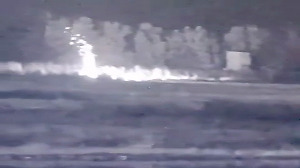'Politics and religion can be a combustive combination, but this once I am pleased that Pinarayi Vijayan made an issue of a rather innocuous tweet by Amit Shah.'
'It provided the perfect excuse to seek respite from political pronouncements and take (temporary) refuge in the classics,' says T V R Shenoy.

Where did Mahabali reign before he left this world? The contrived, utterly idiotic controversy over a tweet by Amit Shah set me wondering. The only possible response thrown up by research is: Mahabali did not rule from Kerala.
Before we get to that, let me touch upon Pinarayi Vijayan's supposed indignation. It might suit the chief minister of Kerala to pretend that he, an activist for a party whose credo is atheism, has suddenly developed the most sincere respect for Hindu tradition.
He may even want us to believe that in all his 71 years he never came upon the link between Mahabali and Vamana. He may even be so ignorant of Hindi that he believes the samast deshavaasiyon in Amit Shah's tweet -- Samast deshvaasiyon ko Vaman Jayanti ki haardik shubhkaamaayein! -- to indicate Keralites alone.
But there is absolutely no reason for us to take any of these absurdities for anything but rich comedy.
And so to Mahabali and, by extension, Vamana.
The tale of Vamana goes back to the Rig Veda, specifically the 18th verse of the 22nd hymn of the first Mandala: 'Trini padaa vi chakrame vishnurgopaa adaabhyah ato dharmaani dhaarayan.' ('Vishnu, the Guardian, whom none can deceive, made three steps, establishing the rightful decrees.')
The problem with Rig Vedic verses is that they are hymns meant to be chanted at sacrifices. There is no context, no clue as to the tales that inspired the poets.
Here, there is no mention of the Daityas, nothing to say what Vishnu's three steps might be.
Some effort at fleshing out the stories behind the hymns is given in later texts such as the Shatapatha Brahmana.
Think of a Satya-Narayana Vrat, where the officiating priest recites the legends as well as performing the rituals, and you get the idea.
The second AdhyayaM (chapter) in the first Kanda (book) of the Shatapatha Brahmana says the Asuras once set about dividing the world after defeating the Devas.
The gods asked for a share, and the Asuras grudgingly responded that they could have as much as the 'dwarf' -- meaning Vishnu -- could encompass.
This introduces some new motifs -- the rivalry between the Devas and the Asuras, Vishnu as a dwarf ('vamana'), and an element of trickery. But there is still no mention of Bali, leave alone of Kerala.
The first reference to the king comes in the Ramayana. Vishwamitra, having asked Dasharatha for the services of Rama and Lakshmana, tells the two princes why he had chosen to live in Siddhashram.
It was, he explains, the very place where Lord Vishnu had meditated as Vamana, and the sage, very succinctly, recounts the story of Bali.
Wherever it might be, Siddhashram was nowhere near Kerala. The Ramayana makes it clear that it was below the confluence of the Sarayu and the Ganga.
For those unfamiliar with the geography of North India, we are talking about Uttar Pradesh and Bihar, at a stretch northern Madhya Pradesh or Jharkhand.
The earliest indication of the scene of the action comes in the 8th Skandha (canto) of the Bhagavata Purana.
It says that Bali's sacrifice was conducted by sages of the Bhrigu clan at a place called Bhrigukacchaka on the north bank of the Narmada. Bhrigukacchaka is a real place, in Gujarat, currently called Broach.
Again, there is no mention of Kerala.
In other words, the oldest Sanskrit texts simply do not speak of any connection between Mahabali and my state. So we turn to something slightly closer home, from Sanskrit to Tamil, whose oldest known specimens are the Sangam literature.
Kerala is not linked, as far as I know, to Mahabali although the Sangam-era authors were aware of the tale.
For instance, the poet Nappoothanar, in his work Mullaipattu says the clouds that sipped water from the ocean now rise above even the mountains 'like Thirumal, who protects the earth with discus and conch, towered as water was poured in his hands.'
One of the best-known works of that era is the Shilappadikaram, the tale of the ankle bracelet.
In its 11th canto, Kadukankadai, the doomed pair Kannagi and Kovalan stop to ask for directions to Madurai; the priest who guides them then goes off to worship 'the Lord who crossed the universe in but three steps.'
I mention the Shilappadikaram because it was written by the Chera prince Ilango Adigal, whose brother Shengottuvan, appears in the epic as the king who built the first temple for Kannagi.
Ilango Adigal was obviously familiar with the story of Vamana and he goes on at length about the greatness of the Chera realm (Kerala) but never connects the two.
Absence of evidence is not evidence of absence, but the silence of the Sangam poets strongly suggests that the tales connecting Mahabali and Kerala are of a (relatively) late origin.
Going strictly by tradition it is impossible that Mahabali ever reigned in Kerala.
Vamana, as Amit Shah's tweet stated, was Lord Vishnu's 5th incarnation; the 6th was Parashurama -- and it is he who supposedly created Kerala.
Having defeated the Kshatriyas 21 times, Parashurama gave away the land he conquered to the sage Kashyapa.
Kashyapa then quickly forbade the warrior-sage from spending a single night on the territory that he had just relinquished; Parashurama hurled his axe southward, and the sea retreated, creating the entire west coast of India, including Kerala.
The transaction between Parshurama and Kashyapa reputedly took place at Bhrigukacchaka. There is an element of irony here.
As Vamana, Mahavishnu had tricked Bali -- Kashyapa's great-great grandson through Hiranyakashipu, Prahlada, and Virochana --m into parting with his kingdom.
Now it was Kashyapa's turn to take gentle revenge on the god by turfing out his 6th avatar.
Logically, it is impossible for Bali, a contemporary of Lord Vishnu's 5th incarnation, to reign from a land created by Parashurama, the 6th incarnation.
Of course, that seeming inconsistency is easily explained. Mahabali supposedly returns to see his subjects (or their descendants), not his land, and those people could have migrated to Kerala from other points long after he himself was exiled.
There are others parts of India that lay claim to pieces of the tale. Uttarakhand boasts of a shrine named Triyuginarayan, over 6,000 feet up in the Himalayas, where Aditi reputedly performed penance to obtain Lord Vishnu as a son.
At the other end of India from Kerala, the people of Assam insist that Bana, son of Bali, ruled from Sonitpur (modern Tezpur).
Karnataka and Maharashtra too mark the day of Bali's annual return, calling it 'Bali Pratipada' (Marathi) or 'Bali Padyami' (Kannada), but they do so on the day after Deepavali.
(By the way, 'Vaman Jayanti' is indeed marked in parts of North India, but always one day before Thiruonam. Amit Shah, who tweeted appropriate greetings on both days, was correct.)
One must also wonder if Mahabali is worth recalling as any sort of ideal monarch. He was undoubtedly a great bhakta and a great conqueror, but he was also, no two ways about it, a ruler who spurned good advice (from his guru, Shukra), whose ego made him prize his own reputation above his duties to his people, and who ultimately led his subjects to their doom.
Of course, those qualities do make Mahabali the archetype of the Indian politician...
Politics and religion can be a combustive combination, but this once I am pleased that Pinarayi Vijayan made an issue of a rather innocuous tweet by Amit Shah.
It provided the perfect excuse to seek respite from political pronouncements and take (temporary) refuge in the classics under the guise of research.






